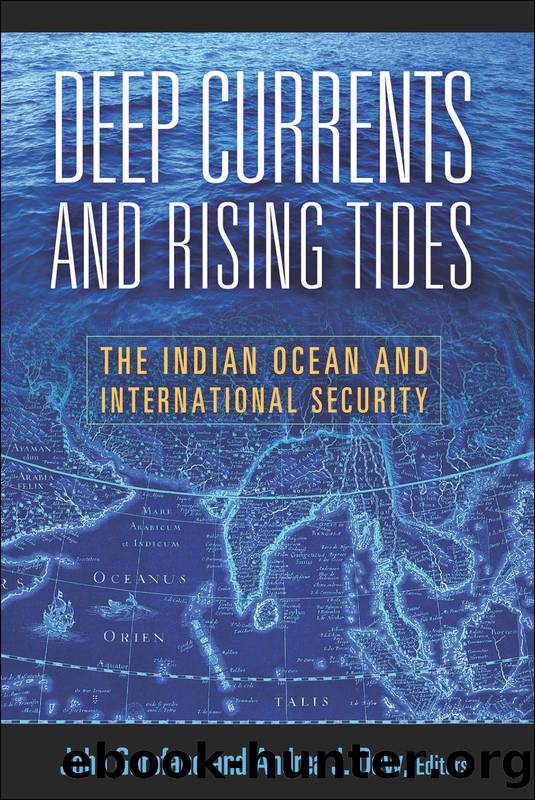Deep Currents and Rising Tides: The Indian Ocean and International Security by John Garofano & Andrea J. Dew

Author:John Garofano & Andrea J. Dew [Garofano, John & Dew, Andrea J.]
Language: eng
Format: epub
Tags: Political Science, Security (National & International)
ISBN: 9781589019676
Google: LXt5GOH7OFQC
Goodreads: 16276972
Publisher: Georgetown University Press
Published: 2013-04-29T00:00:00+00:00
BEYOND THE INDIAN OCEAN: CHINAâS PURSUIT OF SEA POWER
The past ten-plus years have witnessed an emerging Chinese debate between two competing interpretations and visions of the defining nature and direction of the countryâs future power status: whether China is and should remain a continental power or pursue becoming a great sea power. Without a doubt, Chinaâs growing integration into the global economy has raised its awareness of its maritime rights and interests, as have its maritime activities. The Chinese economy is heavily dependent on international trade, and continued growth relies on the safe and secure supply of raw materials and energy, especially oil. While Beijing has been paying increasing attention to the IOR, a so-called sea consciousness has been introduced into the pages of Chinese media and academic journals in recent years. âBlue territoriesâ and âinvisible boundariesâ have become hot topics as Chinaâs interest in and dependence on the oceans increase.
Based on the United Nations Convention on the Law of the Sea (UNCLOS), China has more than three million square kilometers in maritime territories under its management, including continental shelves and the three-hundred-mile exclusive economic zones (EEZs) in the East China Sea and South China Sea. Taken together, these vast maritime territories provide potentially enormous resources for Chinaâs large population. Oceans provide economic lifelines, serve as platforms for military command of the commons, and could be the high frontier of science and technology, and are therefore fertile grounds for competition and control.56
Chinese analysts differentiate between three distinct types of maritime rights for the country: coastal maritime interests and rights; offshore maritime interests and rights; and maritime interests and rights in the high seas. The first covers 18,000 km of coastal lines and an area that contains 40 percent of Chinaâs total population and 60 percent of its annual GDP, with major cities and ports. The second refers to areas stretching from Taiwan all the way to the entire South China Sea, the Diaoyu/Senkaku Islands, the Spratlys, and some 6,900 other small islands and atolls. These constitute both strategic shields for China and passageways into the Pacific and Indian Oceans. The third touches regions of increasing and vital importance to Chinaâs continued economic growth, regions that provide critical resources, raw materials, and energy supplies, from the Middle East to the Gulf, from the Arabian Sea to the Horn of Africa, and from the Indian Ocean to Latin America.57
China has suffered humiliating defeats in the past, and historians argue that one reason was its failure to recognize and develop its sea power. Chinaâs defeat in the Sino-Japanese war of 1894â95 was largely attributed to its backwardness in naval power; in contrast, the US emergence as a global power was based to a great extent on its own sea power. Its decisive defeats of the Japanese fleets and its effective control of the western Pacific helped it prevail over Japan in World War II. During the Cold War, the two superpowers engaged in fierce maritime competition, and the current US global strategy of
Download
This site does not store any files on its server. We only index and link to content provided by other sites. Please contact the content providers to delete copyright contents if any and email us, we'll remove relevant links or contents immediately.
The Radium Girls by Kate Moore(11970)
100 Deadly Skills by Clint Emerson(4879)
Rise and Kill First by Ronen Bergman(4739)
The Templars by Dan Jones(4656)
The Doomsday Machine by Daniel Ellsberg(4449)
The Rape of Nanking by Iris Chang(4165)
Killing England by Bill O'Reilly(3968)
Hitler in Los Angeles by Steven J. Ross(3923)
Stalin by Stephen Kotkin(3918)
12 Strong by Doug Stanton(3526)
Hitler's Monsters by Eric Kurlander(3291)
Blood and Sand by Alex Von Tunzelmann(3164)
The Code Book by Simon Singh(3136)
Darkest Hour by Anthony McCarten(3096)
The Art of War Visualized by Jessica Hagy(2973)
Hitler's Flying Saucers: A Guide to German Flying Discs of the Second World War by Stevens Henry(2731)
Babylon's Ark by Lawrence Anthony(2648)
The Second World Wars by Victor Davis Hanson(2502)
Tobruk by Peter Fitzsimons(2478)
